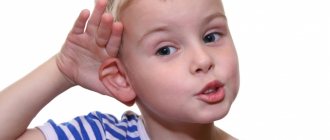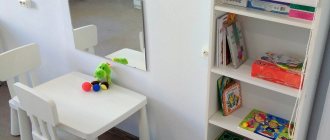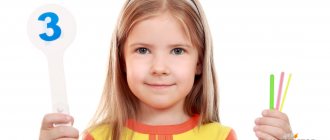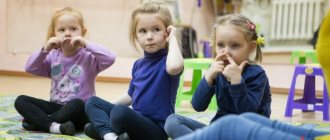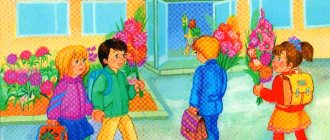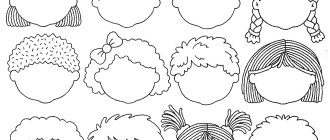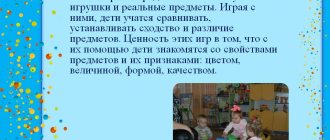Didactic games aimed at enriching the knowledge of preschool children about their hometown
"Wasp Buildings"
Didactic task
. To develop children's powers of observation, the ability to find similarities and differences in the buildings depicted in the pictures, to activate children's vocabulary, to name the historical monuments of the city, to cultivate a love for their hometown.
Game rules
. Select only identical buildings in different pictures. The one who doesn't make a mistake wins. The paired pictures are looked for by the one the arrow points to.
Game actions.
Search for identical pictures. Arrow rotation.
Progress of the game.
Children sit at a table on which pictures are laid out. There are many of them (10 – 12), they are all different, but some of them are the same. Following the direction of the arrow, the child looks for a black and white photograph taken several years ago with the image of the same building. Children name the buildings.
Didactic game “Collect a picture”
Didactic task.
Exercise children in composing a whole picture from individual parts, through the content of the pictures, consolidate children’s knowledge about their hometown, and cultivate love for their small Motherland.
Game rules.
Within a certain time, correctly assemble a whole picture from parts.
Game actions.
Search, folding parts of the picture.
Progress of the game.
The teacher, together with the children, looks at pictures depicting the sights of the city. Explaining the rules of the game, the teacher recalls the already known rule of how to put together a whole picture from individual parts. Having distributed the pictures according to the number of players, the teacher says: “Let’s start!” Children choose the right parts of their picture. Whoever put the picture together first gets a chip. Then you can exchange pictures and repeat the game. You must have 2 sets of pictures: one consists of whole pictures, the other of their parts (at least 9-12).
Didactic game "City Travel"
Didactic task.
To consolidate children's knowledge about their hometown, street names, and city attractions.
Game rules.
The sequence of moves is determined by the thrown dice, and the number of moves is counted with chips. The winner is the one who reaches the finish line first.
Game actions.
Throwing a die, moving a chip along the playing field.
Progress of the game.
Before starting the game, the teacher and the children look at photographs depicting the sights of the city. A short conversation is held about the names of streets and buildings in the city.
The rules of the game are then explained; You can move around the playing field only with the help of a chip, each time counting as many circles as will be indicated on the die, taking into account that a red circle means skip a move, green means move back, blue means forward.
The winner will be the one who makes no mistakes, counts the chips correctly and gets to the indicated place first.
Didactic game “My City”
Game task.
Strengthen your knowledge of the city's attractions. Identify historical monuments, their location, and give their description.
Game rules and game actions
depend on the game version. The route layout on the map may vary.
Didactic material.
A playing field on which the location of the most interesting memorable places is marked, cards of the same size with images of monuments, etc. The content of the cards depends on the version of the game: 1 – image and name of attractions; 2 - description of memorable places; 3 - numbers indicating the location of the monument on the diagram.
Progress of the game.
4-5 children can take part in the game. A map of the city is laid out on the table, and children receive cards depicting memorable places. The teacher offers to go on a city tour and mixes cards with descriptions, placing them face down. The game may gradually become more difficult.
Option 1.
The presenter takes out cards, naming the monument and the number indicating its location on the map. The guys who have a card with an image of the named attraction cover the corresponding place on the diagram with it.
Option 2.
The presenter takes out cards with a description, reads the text, without naming the monument and the number that indicates its location. Children must guess what exactly the teacher is talking about, name a monument or historical place, find it on the map and lay out the correct card.
Option 3.
The presenter takes out cards with numbers. Children who have a card with a picture of the corresponding number of the monument pronounce the desired name and talk about it. The game ends when all the places marked on the diagram are covered with cards. The participant who lays out his cards first wins.
Progress of the game.
It is best to play in a group of 4-5 people. The presenter covers the picture with a sheet of paper with a keyhole and places it in front of the players. view the picture only through the hole, gradually moving the top sheet, but without lifting it. Everyone looks at it at the same time, but everyone moves the sheet for a minute. Then the presenter suggests that someone tell what is shown in the picture , the others correct and complement it. At the end of the game the picture opens and the presenter announces the winner who told the story most correctly and in detail. He replaces the leader. As a complication: first the keyhole is larger, then the size decreases.
Didactic game “Contours and shadows”
.
Goals of the game:
1. to form children’s ideas about the diversity of architectural buildings in our city ;
2. consolidate the concepts of “Architecture”
and
"Sculpture"
;
3. develop visual attention and perseverance;
4. cultivate interest in your hometown .
Didactic material on the topic “Our home, our city, our country”
Assignment: Read a story to your child, answer questions with him, and then play games.
“There are a lot of countries on Earth. Our country is Russia. This is our Motherland, the place where you were born, where you live with your parents and friends.
Each country has a flag, anthem and coat of arms. Our Russian flag has three stripes. White means purity and justice. Blue is a peaceful sky. Red - strength and beauty. This flag was introduced into Russia by Tsar Peter the Great. When the national anthem is played and the national flag is raised, the citizens of this country stand.
Each country also has its own coat of arms. The coat of arms of Russia is a double-headed eagle.
Our Motherland is huge, it has a lot of cities, villages, rivers, lakes, seas. The most important city in the country is called the capital. The capital of Russia is the city of Moscow. You live in a city, town or village, and this place is necessarily marked on the map.
But besides this, each person has his own home. People all over the world live in a wide variety of homes. They build them from various materials. Some houses are built of brick or stone, others of wood, clay or reeds.”
Ask your child questions:
— What is the name of our country? Name the capital of our Motherland. — What color is the flag of our country? — Who introduced this flag into Russia? — What is the name of your hometown or village? - Give me your home address. — What material can people build their house from?
1. Complete the sentence.
My country is called ... (Russia) The capital of our country is ... (Moscow city) My city (village) is called - ... My home address is ...
2. Choose as many words as possible to match the adult’s word.
Country (which?) -... (huge, beloved, beautiful, only, rich, powerful, endless) City (which?) -... (big, small, clean, green, well-groomed, dear, etc.)
3. Who lives in their native land? Circle the plants and animals that can be found in your area.
4. There is always a lot of traffic on the streets of our cities and therefore you need to be careful. Look at the pictures and tell which child is behaving incorrectly. Highlight them.
5. A red car drives to a house with a blue garage. Travel with the car: tell it what it will go past, where it will turn, where it will stop and why before it reaches the garage.
6. Name the parts of the room and the house.
Door, window, ceiling, floor, walls.
Balcony, stairs, roof, walls, windows, doors. (House)
7. Help each hero find his home. (Draw the lines). Think like this: “Carlson lives on the roof,” etc.
8. Name the rooms in the house.
Living room, bedroom, hallway, bathroom, children's room, kitchen, utility room (storage room), dining room.
9. Choose as many words as possible that will tell you what we do in different rooms of the house (apartment).
In the living room (what are they doing?) – watching TV, relaxing, receiving guests. In the bedroom (what are they doing?) - they sleep, rest, In the hallway (what are they doing?) - they dress, undress, take off their shoes, put on their shoes, greet, see off (guests). In the bathroom (what are they doing?) - they wash, shower, take a shower, bathe, brush their teeth, comb their hair, etc. In the nursery (what are they doing?) - they play, teach, study, sleep, relax, etc. In the kitchen (what are they doing?) - they cook, boil, fry, cut, wash (dishes), eat, etc. In the dining room (what are they doing?) - they have breakfast, lunch, dinner.
10. Tell us what houses are like.
The house has many floors - it is... (multi-storey) The house has one floor - it is... (single-storey) The house has many apartments - it is... (multi-apartment) The house has one entrance - it is... (single entrance) The house has many entrances - it is (multi-entrance) House built of brick - it is ... (brick) Made of wood - ... (wooden) Of blocks - ... (block)
11. Who do you think the artist forgot to draw in the empty window? Finish it.
12. Think and tell where Pinocchio is standing, using the words at, for, because of, between, right, left.
Pinocchio is standing behind the house. To the right of Buratino is a one-story house. To the left of Buratino is a multi-storey building. Buratino stands between a multi-story and a one-story building. Pinocchio is standing near the house. Pinocchio looks out from behind the house.
13. The tallest clown lives in a house, to the right of which a birch tree grows, the shortest one lives in a house, behind which a Christmas tree grows. Draw lines from the clowns to their houses.
14. Compose the story “Home Alone” from the pictures and write it down. Don't forget to put it in your story book.
Sample story:
“Vanya and his faithful friend Tuzik love to play together. But Vanya goes to school and cannot play with Tuzik all the time. Before leaving for school, Vanya strictly ordered Tuzik not to be naughty and to behave exemplarily. But after the boy left, Tuzik became bored and forgot about what Vanya was punishing him. He grabbed the tablecloth in his teeth and began to rush around the house with it. When the boy returns from school, he will have to put his house in order for a long time.”
Teacher-speech therapist Gomzyak Oksana Stepanovna
- Summary of a speech therapy lesson on the topic “Our Country”
- Summary of the educational activity “We love our city very much”
- Summary of logorhythmic lesson [Country Mylyandiya]
- Scenario for speech therapy leisure “Journey to the City of Beautiful Speech”
- Summary of a lesson on teaching older preschoolers literacy “Journey to the city of Zvukograd”
( 7 liked, average score: 5.00 out of 5)
Loading...
Progress of the game:
The teacher tells the children that guests are arriving in their city . They need to be placed. Guests have business cards with their address written on them. There is a table for these addresses. You need to look at the numbers shown on the card . The first digit indicates the line number, and you need to look for it in the first column from top to bottom, and the second digit indicates the column number and you need to look for it in the top line from left to right. Having found the desired fragment, you must find out what kind of building it is, find it and come up with a sentence with this word. The one who completes all the tasks correctly wins.
Thank you for your attention! I hope that these materials will help you in working with children.
Progress of the game:
Children are invited to match cards to images of architecture and sculpture (on one side is the shadow of a building, and on the other side is its outline image).
Didactic game “Seating guests in the city of Kolpino ”
Goals:
1. to develop children’s knowledge about the architectural buildings of our city ;
2. develop the ability to navigate in space;
3. consolidate the ability to use a table, the ability to find columns and lines;
4. fix the ordinal count from 1 to 9;
5. develop the ability to correlate part of an image with the whole;
6. develop coherent speech and speech - evidence;
7. develop attention , memory;
8. cultivate interest in their native land.
Materials: cards with images of buildings in our city , a table with fragments of buildings located on it, cards - business cards with images of guests and their numerical address.
